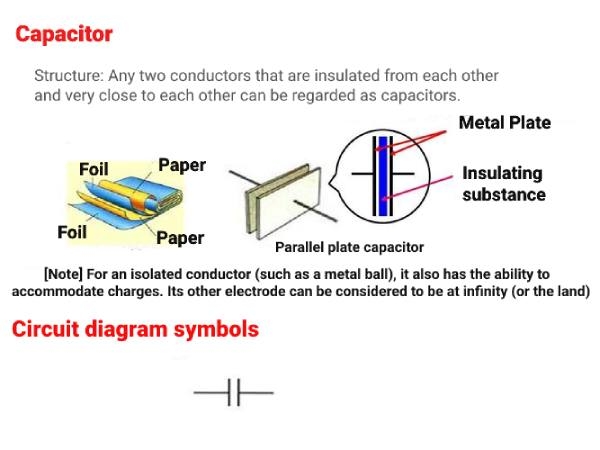1 Capacitor overview
1.1 What is capacitance
What is capacitor? Before explaining this question to you,let’s first understand the capacitance.As the name suggests, it is the ability to store electricity. The university physics book says that “for any ‘isolated’ conductor that is not affected by the outside world, when the conductor is charged, the ratio of the charge q carried by the conductor to the corresponding potential U is C. This ratio C is a physical quantity that has nothing to do with the charge carried by the conductor , known as the “capacitance of the ‘isolated’ conductor” that is
C=q/U

The capacitance characteristic of a conductor is a unique property of a conductor, which is equal in magnitude to the electric charge carried by the conductor when the potential of the conductor is one unit.
In the International System of Units, the unit of capacitance is farad(F). If the electric charge carried by the conductor is 1 coulomb(C), and the corresponding potential is 1 volt (V), the capacitance of the conductor is 1 farad, which can be represented by the capital letter F. If you feel that the unit of farad is too large, you can also express it in smaller units such as mF, uF, nF, pF, etc. Their relationship is as follows
1F=1000mF=106uF=109nF=1012pF (1.2)
1mF=103uF=106nF=109pF=10-3F (1.3)
1uF=103nF=106pF=10-3mF=10-6F (1.4)
1nF=103pF=10-3uF=10-6mF=10-9F (1.5)
1.2 What is capacitor
What is capacitor? As the name suggests, it is a device that holds charges. When there are other objects around the conductor, the capacitance of the conductor will be affected. Therefore, it is necessary to design a conductor combination with a large capacitance value and a geometric size as small as possible without being affected by other objects. Such a combination of conductors is a capacitor. The concept of a capacitor in physics can be expressed as: “a conductor system composed of two conductors when there are no other charged conductors around it.” The capacitance (or capacitance) of a capacitor is defined as: when the two plates of the capacitor have the same electric charge q, the ratio of the electric charge q to the corresponding potential difference UA-UB between the two plates, that is
C=q/UA-UB (1.6)
An isolated conductor can actually still be considered a capacitor, except that the other conductor is at infinity and has zero potential. Formula (1.6) becomes formula (1.1). Therefore, it can be seen that the capacitance of the so-called “isolated conductor” is actually the capacitance between two conductors. Unlike ordinary capacitance, the other conductor is only at infinity. But capacitance is a characteristic between conductors after all. Conductor capacitance is virtually non-existent.





